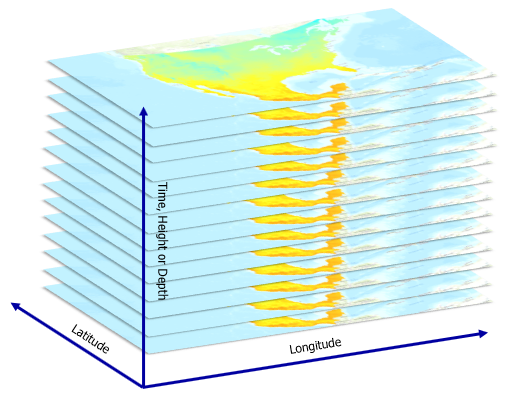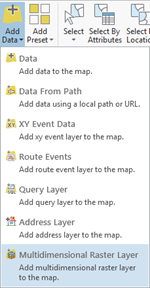Multidimensional data represents data captured at multiple times or multiple depths or heights. This data type is commonly used in atmospheric, oceanographic, and earth sciences. Multidimensional raster data can be captured by satellite observations, in which data is collected at certain time intervals, or generated from numerical models, in which data is aggregated, interpolated, or simulated from other data sources.

The common storage formats for multidimensional raster data are netCDF, GRIB, and HDF. Oceanographic data is often stored in netCDF format (.nc file), weather data in GRIB format, and NASA often uses HDF format to store scientific data. These multidimensional formats share common capabilities for storing multiple variables, with each variable being a multidimensional array. Esri Cloud Raster Format (CRF) and mosaic dataset also support multidimensional raster data storage. For example, multidimensional data can include temperature, humidity, and wind speed for every month from 2010 through 2020, and at elevations of 0, 1, and 10 meters, respectively. See Multidimensional raster types for more information.
You can use ArcGIS AllSource to visualize, manage, and process multidimensional raster data, as well as publish it as a web service. Adding a multidimensional raster layer to the map view allows you to explore your variables in one file, and the Multidimensional contextual tab provides an interactive way for you to display the data slices you want and access the tools and functions for processing multidimensional raster data quickly.
Manage multidimensional raster data
Multidimensional raster data is large and can be challenging to manage. The primary data management structures for managing multidimensional raster data are the multidimensional mosaic dataset and the multidimensional CRF.
Multidimensional CRF
CRF is the default output raster format for geoprocessing tools that generate multidimensional rasters. The .crf file is optimized for writing and reading large files in a distributed processing and storage environment. In a .crf file, multidimensional raster data is divided into smaller bundles of tiles, which allows multiple processes to write simultaneously to an output.
The multidimensional CRF supports storing multiple variables, dimensions, and processing templates. It also supports appending and replacing data, but it does not support inserting or deleting. You can store the data using LERC and LZ77 compression methods to help minimize storage requirements. The multidimensional CRF is a faster option when accessing a large number of slices over time, for example, when performing temporal profiling. The multidimensional CRF dataset is recommended for the following scenarios:
- The data will be used mainly for multidimensional analysis, including temporal profiling and use with tools in the Multidimensional Analysis toolset. A transposed CRF will improve performance.
- You plan to publish a multidimensional image service in the cloud and place the data in cloud storage. CRF data is designed for higher performance in cloud storage.
- The multidimensional data is currently stored in a low-performing format (for example, irregularly gridded data). It is recommended that you convert the data to CRF to improve performance.
Multidimensional mosaic dataset
The multidimensional mosaic dataset is an effective way to store and manage data and perform data analysis.
The multidimensional mosaic dataset supports storing multiple variables, dimensions, and processing templates. It also supports appending, replacing, inserting, and deleting data through table operations. You must rebuild the multidimensional information after any change is made. The storage requirements for a mosaic dataset depend on the source images in the dataset, since the mosaic dataset does not store pixels. The multidimensional mosaic dataset is recommended for the following scenarios:
- You want to maintain access to overlapping images for a single time slice.
- The data includes large, spatially discontinuous areas. For example, Alaska and Hawaii are not adjacent to the contiguous United States and will generate a large area of NoData if CRF is used, resulting in additional storage needs.
- The data will be used mainly as a catalog of images, and no temporal profiling will be done.
- The data will be updated regularly with new insertions and deletions (not only appending data).
- You have multiple data types with a different number of bands. For example, the dataset contains temperature data (one band) and Landsat 8 data (eight bands).
You can convert a multidimensional mosaic dataset to a CRF dataset. To do so, use the Copy Raster tool, choose CRF as the output format, and check the Process as multidimensional check box. Optionally, you can build a multidimensional transpose.
Modify multidimensional data
The tools in the Multidimension toolbox allow you to modify existing multidimensional rasters, generate multidimensional metadata in a mosaic dataset, transpose data for optimized performance, and extract subset datasets. A number of standard raster data management tools also support multidimensional data such as Resample, Clip, and Calculate Statistics. Additionally, you can project and transform spatial data using the tools in the Projections and Transformations toolset, many of which support multidimensional rasters.
You can modify the description, unit, and color map of each variable in a multidimensional raster dataset in the Properties pane, which you can access from the Catalog pane. You can also set the default variable to be displayed or analyzed in the Properties pane.
Visualize multidimensional raster data
Multidimensional mosaic datasets and .crf files can be added directly to a map in ArcGIS AllSource.
To add a multidimensional netCDF, HDF, GRIB, or Zarr format file as a multidimensional raster layer, click Add Data > Multidimensional Raster Layer on the Data tab.

By default, the system applies the Multidimensional Raster processing template and creates one multidimensional raster layer for each selected variable. The new raster layer contains the multidimensional information from the variable, which can be visualized, analyzed, and shared. You can also combine the selected variables into one multidimensional multivariate raster layer. Alternatively, you can use the Make Multidimensional Raster Layer tool to generate a layer from supported multidimensional data types.
Once the multidimensional raster layer is in the map view, you can display the slices you want to see using the options in the Current Display Slice group on the Multidimensional tab. The Multidimensional Extent allows you to define the extent in time or other dimensions. Slices outside the defined extent will not be displayed nor be included in the analysis.
For more information about displaying a multidimensional raster layer, see Work with multidimensional raster data.
For information about visualizing a multidimensional mosaic dataset, see Visualize a multidimensional mosaic dataset.
A multidimensional layer may contain multiple variables. If you want to define and persist symbology for each variable, you need to register the symbology and save it with the layer file. For more information, see Register symbology for multiple variables.
Analyze multidimensional raster data
Complex time series analysis, height or depth trend analysis, forecasting, and regression are all possible in ArcGIS AllSource.

You can also use the temporal profile chart to visualize and analyze multidimensional raster data.
For more information, see Multidimensional analysis in ArcGIS AllSource.